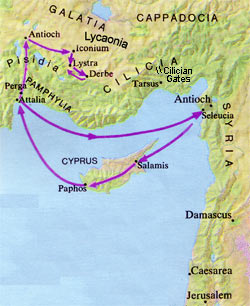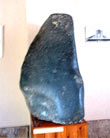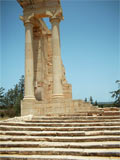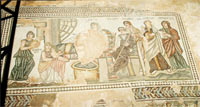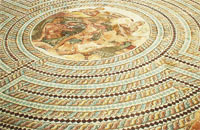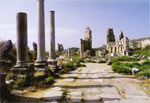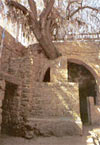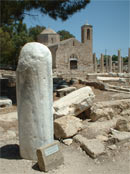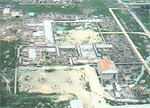The curious route of St Paul's first mission
In the 1st century, Cyprus was most noted for its copper and devotion to the goddess Aphrodite. Sacred marriage, orgiastic ritual and temple prostitution were aspects of her cult, but the goddess was also a protector of marriage, children and seafarers.
Perhaps the cult (rather than the copper) attracted Paul's attention. The most obvious route from Antioch to the cities of Lycaonia and Pisidia was overland through the Cilician Gates, the route favoured for his 2nd and 3rd journeys.
Having already got as far as Derbe, Paul could easily have crossed the Cilician plain to reach his home town. Yet we are told he retraced his steps and took a voyage back from Attalia instead.
Aphrodite – the original beauty
Sanctuary of Aphrodite (Kouklia, Cyprus)
Before assuming the form of a classic beauty, the fertility goddess was worshipped as a black conical stone, under the name Great Goddess or Astarte.
In the 4th century BC local Cyprian gods took Greek names and Astarte became Aphrodite, Hylates Apollo, Eshmun Asclepius, etc.
"In Syria ... is the temple of Aphrodite Urania – the most ancient, I am told, of all the temples of this goddess. The one in Cypress the Cyprians themselves admit was derived from it."
– Herodotos (5th century BC)
Apollo's worship started at least as early as the 8th century BC and continued until the 4th century AD prohibitions of Theodosius.
Temple of Apollo Hylates, Curium. Refuge from the wrath of Barnabas?
The baths at Curium.
At the end of the 4th century, the sacred Nymphaeum was converted into a church and the changing rooms re-purposed as a bakery. On the ruins of the forum and other official buildings arose the bishop's church and residence. Kilns reduced marble statues and architectural pieces to lime.
From Iconium ("city of icons").
Pagan tastes of the Proconsuls at Paphos
A gathering of Hellenic gods in the Governor's residence.
Excavations at Paphos have brought to light numerous mosaics and statues of Greek gods and heroes.
A magnificent circular mosaic in the governor's palace. In the centre, Theseus kills the Minotaur (hence aka "House of Theseus").
Paul was here?
A modest 16th century church (Agia Kyriaki Chrysopolitissa, Paphos) sits within the ruins of a much larger 4th century structure, itself built upon an even larger pagan sanctuary.
Downsizing piety?
Jew free?
After the violent Jewish rebellion of 115/6 – led by the messianic claimant Artemion – a law prohibited Jews from even stepping on Cyprian soil, even if shipwrecked.
Paul was here?
Perge (Perga) – in ancient times a coastal city. In Acts 13.13 John (aka "Mark") leaves Paul here and returns to Jerusalem. Perhaps he knew those Jews were going to cut up rough.
"Death for Naked Racing"
– the 5th century Christian mind
"And we found that a certain abominable race was being performed in the road near the city, where a multitude of women and men naked were performing the race. And there was great deception and error in that place.
And Barnabas turning, rebuked it; and the western part fell, so that many were wounded, and many of them also died and the rest fled to the temple of Apollo, which was close at hand in the city, which was called sacred."
– The Acts of Barnabas.
Ancient tomb given a Christian makeover
Agia Solomoni, Paphos – with "lucky" tree bedecked with scraps of rag and plastic bags. Inside, more Jesus trash.
Byzantine claims for the small catacomb included "final resting place for the seven Maccabee brothers". As if.
All that glitters. Kykkos monastery in the Troodos Mountains of Cyprus was bequeathed properties as far a field as Russia.
The holy complex includes its own liquor store for those who don't get intoxicated on a sacred finger in a golden casket.
Did Saint Paul, native of Tarsus and Roman citizen as he claimed, really make the journeys ascribed to him – or are they just a frame upon which to hang his seminal epistles? Did this erstwhile Rabbi Saul, student of Gamaliel and Pharisaic Jew, really sally forth over sea and mountain – or could the story of his travels have been concocted precisely to framework missives of orthodoxy aimed at recalcitrant synagogues of the Jewish diaspora? A century of archaeology appears to confirm a few circumstantial details mentioned in his letters and yet the biblical account gives one cause to wonder.
On the Island of Love What better way to begin the mythology of Christian triumph in the Gentile world than a spectacular conversion? For Paul's first adventure on the missionary path the chosen venue was Cyprus, a strategically placed island ruled by the Ptolemies of Egypt until annexed by Rome in 58 BC. Many of the vast number of rock-cut tombs on the island follow the peristyle fashion of Egypt. Mark Antony gave the island to Cleopatra as a wedding gift but it was restored as a Roman province after the Battle of Actium (31 BC). Economically prized for its copper mines (half of which were awarded to Herod the Great by Augustus), in 22 BC the island became a senatorial province, under the rule of a propraetor (although granted the honorary rank of proconsul). Aside from a severe earthquake in 77 AD and a violent Jewish insurrection in 115/6, the peaceful, prosperous island barely figured in Roman histories. But it seems that Paul's co-worker, Barnabas, was a Jew from Cyprus, so what better place to start the grand missionary tour than Barney's homeland? (Well, actually, a more obvious choice would have been the cities of the Decapolis – thoroughly Gentile and far more accessible). Paul's first journey, so it is said, began about the year 46 AD, after the apostle had passed more than 10 years in retirement at Tarsus, performing no evident work for the Lord or even maintaining contact with the brethren. Yet Paul is chosen by the church in Antioch (or rather, by the Holy Spirit) to carry the good news to Cyprus and Asia Minor. (Not that he was really the first – Acts 11.19 tells of unnamed "scattered" brethren already there, preaching to the "Jews alone". The aside is very important, as we will see). After a stopover at Salamis the apostles "go through" the island (the cities of Citium, Amathus and Curium don't get a mention) and make straight for the Governor in Paphos, who conveniently has sent word that he wants to hear them. (Why, one wonders? Did they cause such a commotion at the other end of the island? And if so why do we not know of it?) All it takes is the spiteful blinding of a rival magician (curiously named "Bar Jesus") and Sergius Paulus, Roman aristocrat and doubtless the richest, as well as the most powerful, man on the island, is enrolled among the ranks of the Christians. "By tradition" Cyprus becomes the first country governed by a Christian, though oddly we never hear of Sergius again, and nor is there any evidence of early Christianity on the island. Hereafter, Rabbi Saul is known by his latin name Paulus (which just happens to be the name of the Governor).
One good yarn deserves another Not only was Paul a soar away success with proconsul Sergius – he also got given a thrashing by him! Sounds a little contradictory? Well, it is another "Church tradition" so all things are possible. But for this yarn, remarkably, there is physical evidence – a remnant of the very column about which Paul was whipped! Apparently, the faithful can reconcile the two ideas by insisting Paul first was thrashed by and then converted the governor to Christianity (it will only take you a moment to dream up the movie script – speak to Mel Gibson). The miraculous upshot of all this is that a stump of marble selected at random in modern times provides "proof" for the missionary activity of Paul and, ipso facto, "evidence for Jesus." If you can believe this, you probably believed there were WMDs in Iraq and your government would not lie to you.
Reality Check
Facing down the "children of the devil"
We thus reach a crucial point in the whole Christian saga: "We turn to the Gentiles", says Paul.
Not unexpectedly, "the Jews" had Paul and Barnabas expelled from the city. None abashed, our intrepid heroes dust themselves off and journey a hundred miles further east to the city of Iconium (modern Konya). Here the drama repeats itself (although the apostles supposedly "abode a long time" in the city). They speak "boldly" in the synagogue, divide the whole city into "believers" versus "the Jews", and precipitate threats of a stoning. Paul and Barnabas now flee south and east to Lystra (Hatunsaray) and Derbe (Kerti Hüyük). In Lystra, a pronouncement from Paul allows a lame man to walk (the trick closely parallels Peter's healing in Acts 3). The miracle causes the locals to declare Paul to be the god Hermes, and Barnabas, oddly, to be the king of the gods, Zeus. As it happens, the visit of Zeus and Hermes to Phrygia is to be found in Ovid's 1st century anthology of myths "Metamorphoses" but surely "Luke" didn't copy the idea? The adulation of the apostles is short-lived, however, because Paul launches a diatribe against an imminent sacrifice to the very god Barnabas is thought to be. The people, now stirred up "by Jews" from far off Antioch and Iconium (do they just happen to be there or have they followed the apostles for 150 miles?) stone Paul and dump his "dead" body outside the city (Acts 14.19). However, miraculously he "rose up" and returns to Lystra. By the standards of Paphos, this wondrous working of the Holy Spirit should have converted the entire city, if not the whole of Lycaonia. Yet instead of dazzling the multitude with his recovery (or is it a resurrection?), the very next day the dynamic duo make off to Derbe, a further 50 miles southeast. (They are now less than 200 miles from Paul's home town of Tarsus).
In Derbe the apostles "preached, taught and exhorted" many. They then retrace their steps through the hostile towns of Lystra, Iconium, Antioch, evangelise Perge (ignored first time round), and ordain elders "in every church" (Acts 14.23). Evidently all the earlier enmity had abated (or the story teller has run out of story) and churches had sprung up like mushrooms emerging from horse manure. An uneventful voyage home allows the heroes to regale the brethren of Antioch "how they had opened the door of faith unto the Gentiles." Jolly well done. We now have Christian communities all over Asia Minor. But is it fact or fiction?
Theological Agenda Viewed without the rose-tinted spectacles of Christian faith, the first voyage of Paul is as fanciful as the first voyage of Sinbad. Improbable, unlikely incidents are juxtaposed with the miraculous and the ridiculous. Faith can offer special pleas for every incongruity but logical thinking cannot. The first missionary journey of Paul has a clear theological agenda: to portray "the Jews" as obdurate and villainous and to record the supposed successful establishment of a network of Pauline churches among the Gentiles. In each little drama – the contest of magicians in Paphos, the "envy" encountered at Pisidian Antioch, the "threats" of Iconium, the attempted murder in Lystra – the Jews are demonised, "just won't listen" and try to stop the "good news" of Jesus Christ reaching the ears of the Gentiles. Clearly, the Jews are the children of the Devil. In contrast, the Gentiles everywhere, from the Governor at Paphos to the crowds of Derbe and Perge, are instantly, wildly enthusiastic – abandoning their traditional religions with alacrity. Even Jesus did not establish churches with such panache. And what does Paul have to offer them? He has no Gospels (they have not yet been written); he has no first hand reminiscences of his Lord and Saviour (he never met the guy). What can he say of the Disciples he never met ? ("But I saw no one else of the apostles, only James the brother of the Lord" – Galatians 1.19). For the story to work, Paul has indeed to be "filled with the Holy Spirit" – has to be a veritable brigade of Billy Grahams or Ted Haggards on speed. To regard it as "history" requires a suspension of all critical thought, a huge leap of faith and a large measure of self-deception. The yarn works, but only if we view the story through Christian eyes. From the very first, everywhere they tread, the servants of the Lord carouse with kings, governors, grand dames and the leading men of their day. The Holy Spirit which accompanies them ensures their entry into all the best parties and rescues them from all the worst scrapes. But if there is no Holy Spirit then we are dealing with sacred myth not history.
Postscript: Fraudulent in tooth and claw Later accretions to the story of the apostolic mission allow us to better appreciate just how the Christian fabrication factory works. In the real world, fierce rivalry between ambitious clerics was the surest spur to the miraculous. In the 4th century, Salamis, on the eastern end of the island of Cyprus, gained a new sycophantic name, Constantia, in honour of the pious if stupid emperor Constantius II (337-361). The renamed city was the stomping ground of the patriarch Epiphanius, who spearheaded the destruction of pagan shrines which had existed for a thousand years. For nearly forty years (until 403) Epiphanius exerted his authoritarian influence across the eastern Mediterranean, seeking to control the affairs of Antioch, Jerusalem, and Alexandria. Strictly speaking his own see was actually subordinate to that of Antioch but Epiphanius's answer was to promote the local hero St Barnabas (Agios Varnavas) as "founder of the Church" (his church) in Cyprus, often pushing Barnabas ahead of Paul in the apostolic pecking order. Naturally, Barnabas, the Cypriot Jew, was accorded a suitable "martyr's death". The 5th century "Acts of Barnabas" records that it was Jews led by Bar-Jesus of Paphos – enraged by the saint's condemnation of "naked racing", idol festivals in the theatre, and libations in the temples (boy are we talking sin) – who seized, throttled and "burned to dust" poor old Barnabas. Antioch lost control of Cyprus at the Council of Ephesus in 431 but in 488 Peter the Fuller, the ruthlessly ambitious Patriarch of Antioch, revived the claim. The then Archbishop of Constantia, Anthemios, met the challenge with a dream, which it seems led him to an hitherto unknown tomb of Barnabas where he found nothing less than the original edition of Matthew's Gospel! Presented to the credulous Emperor Zeno (474-491), the Cypriot Patriarchy gained in return imperial privileges, that is, total authority over its own bailiwick. Theocracy now reigned in the island of love. Ever after, the boss of bosses, His Beatitude the Archbishop, has flaunted the sceptre rather than a pastoral staff, worn a pretty purple mantle and used red ink in official decrees.
Holiness that has no limits Another 5th century creation was "St Irakleidos", son of a pagan priest, we are told, who guided the apostles around the island (new adventures unrecorded in Acts? or did they simply get lost?). In any event the son of a pagan converted and was made first bishop of Cyprus by Barnabas – thus setting in place the requisite "apostolic succession" which has justified the authority of every subsequent bishop. A tireless exorcist, Irakleidos was rewarded with the obligatory martyrdom (those dastardly pagans again). His skull – well someone's skull – is the star attraction of the 18th century monastery at Tamassos, his purported birth place. Not so far from Tamassos, a rival monastery, Kykkos, can make no claims of "apostolic foundation" but instead has a jaw-dropping icon – nothing less than an image of the Blessed Virgin Mary painted by St Luke himself! Despite the reputed "powers" of the icon (rain-making as well as healing) it could do nothing to stop the monastery burning down in 1365, 1542, 1751 and 1831. But it must be genuine because the monastery is the richest on the island, with a collection of gold artifacts worth millions. Shame that the icon – "too sacred for human eyes to gaze upon" – has not been seen for centuries. Ah well, that's show business.
Sources:
'Save' a friend e-mail this page
Copyright © 2006
by Kenneth Humphreys.
|
||||||||||||||||||||||||||||||||||||||||||||||||||||||||||||||||||||||||||||
